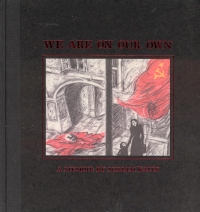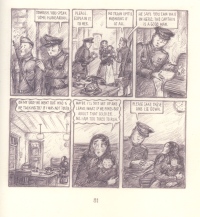| ________________
CM . . .
. Volume XIII Number 2 . . . .September 15, 2006 
 |
We Are on Our Own: A Memoir.
Miriam Katin.
Montreal, PQ: Drawn & Quarterly, 2006.
122 pp., cloth, $24.95.
ISBN 1-896597-20-3.
Grades 9 and up / Ages 14 and up.
Review by Harriet Zaidman.
**** /4 |
| |
|

excerpt:
Be smart. Be crafty. Find a way to vanish.
The existence of God was a question that Miriam Katin faced as a very young child. “Was it God or her mother’s cleverness that saved their lives during the Nazi terror in Hungary during World War II?” is a question that she has dealt with all her life, a life she chronicles in her moving graphic novel, We Are On Our Own.
Using black and white pencil drawings, Katin juxtaposes her childhood under the Nazis and her life as a mother in the United States, the latter rendered in colour.
Katin’s story began in 1944 when the Nazi occupation began to tighten its vice grip on the Jewish population of Hungary. The drawings show Esther Levy, Miriam’s mother, meeting her non-Jewish friend in a Budapest café. The women puzzled at the edict requiring Jews to relinquish their pets to the authorities. While Miriam, an unknowing two-year-old, fed ice cream to her dog, Rexy, the women discussed their concerns for the future. There were rumors that Jews were being deported and disappearing without a trace. Events escalated rapidly, and, when Esther was ordered to move into a ghetto, she planned their escape. Burning anything which might reveal her as a Jew, she bought false identity papers and transformed herself into a village servant girl with an illegitimate daughter.
Fleeing Budapest, Esther and Miriam began a journey in which every day was an uncertainty. Esther learned to blend in, to lie and to do whatever she had to do to protect herself and her daughter. She and Miriam encountered both uncommon friendliness and hostility from their fellow countrymen. They endured the wrath of winter, hunger, fatigue and hopelessness. Maintaining their cover meant that Esther was forced to become a mistress to a German officer, and she was later raped by Russian soldiers. Throughout, Esther believed that God had saved her and Miriam.
 When the war ended, a semblance of normalcy ensued. Esther’s husband, Karoly, who had been fighting with the Hungarian army, eventually found his wife and daughter, one of the too few happy reunions that occurred. Karoly rebuked Esther for “giving thanks to a deadly sky.” Esther asked how they could go on without God, to which Karoly responded : “The same way you have arrived here. On your own. We are on our own, Esther. That’s all there is.”
When the war ended, a semblance of normalcy ensued. Esther’s husband, Karoly, who had been fighting with the Hungarian army, eventually found his wife and daughter, one of the too few happy reunions that occurred. Karoly rebuked Esther for “giving thanks to a deadly sky.” Esther asked how they could go on without God, to which Karoly responded : “The same way you have arrived here. On your own. We are on our own, Esther. That’s all there is.”
Miriam, as a child witness to these events and conversations, came to the same conclusions as her father. She married to an American man who did not experience the horrors of the war, and she was uncomfortable with his wish to give their sons a religious education. She was unable to lie to them about her views.
By itself, Miriam Katin’s story is a valuable contribution to the history of the Holocaust. Her interpretation of her life in graphic novel format adds another level of meaning, especially for young adult readers. Katin is an accomplished artist who has worked as a graphic artist and as an animator for MTV and Disney. She has created three narratives in the story: the words that are exchanged between the adults, the drawings of what was happening, and the child’s view of a world gone awry. The child’s view includes play and blissful ignorance of what is really going on. Miriam comforted her mother who wept with shame after she was forced to submit to the German officer. She assured her, “He will come back, Mommy. Don’t cry.”
The dangerous moments, the evil of the Nazis, and the kindness of Esther’s benefactors are conveyed through Katin’s rough shading techniques and by having the parts of the drawings or word balloons travel across the boxes.
Coloured pages that depict Katin’s life as a mother in New York are interspersed throughout the book. The ghosts of her past were always present, but she created a happy environment for her children.
Teens and adults who are attracted to this form of book will learn much about history through this memoir. Those who are interested in art will see an excellent example of how a story can be told using an alternative format.
Katin credits her mother with teaching her how to laugh and to forgive. With We Are On Our Own, Katin teaches the same lesson to us.
Highly Recommended
Harriet Zaidman is a teacher-librarian in Winnipeg, MB.

To comment
on this title or this review, send mail to cm@umanitoba.ca.
Copyright © the Manitoba Library Association. Reproduction for personal
use is permitted only if this copyright notice is maintained. Any
other reproduction is prohibited without permission.
NEXT REVIEW |
TABLE OF CONTENTS FOR THIS ISSUE
- September 15, 2006.
AUTHORS |
TITLES |
MEDIA REVIEWS |
PROFILES |
BACK ISSUES |
SEARCH |
CMARCHIVE |
HOME |

 When the war ended, a semblance of normalcy ensued. Esther’s husband, Karoly, who had been fighting with the Hungarian army, eventually found his wife and daughter, one of the too few happy reunions that occurred. Karoly rebuked Esther for “giving thanks to a deadly sky.” Esther asked how they could go on without God, to which Karoly responded : “The same way you have arrived here. On your own. We are on our own, Esther. That’s all there is.”
When the war ended, a semblance of normalcy ensued. Esther’s husband, Karoly, who had been fighting with the Hungarian army, eventually found his wife and daughter, one of the too few happy reunions that occurred. Karoly rebuked Esther for “giving thanks to a deadly sky.” Esther asked how they could go on without God, to which Karoly responded : “The same way you have arrived here. On your own. We are on our own, Esther. That’s all there is.”